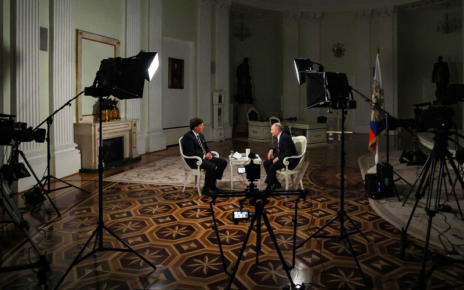At its essence, foreign policy is a story. Through its formulation and intentions, foreign policies reflect how governments perceive their place in the world. While these narratives often change, some endure through decades of new presidents and shifting priorities, drawing upon older concepts and beliefs before emerging in official doctrines. One of the most recent and prominent of these types of narratives is the China Threat Discourse (CTD), which alleges that the rise of China over the past two decades poses a clear and present danger to the US and the rules-based international order. This discourse, akin to the US’ long-standing fears of the rise of an Indo-Pacific hegemon, such as Japan in the 1970s and 1980s, regards China both as a direct challenge to the US’ military strength in the region and the West’s technological and economic advantages. Further, the CTD’s emergence, produced in part by the US’ fears of its own decline, and its influence on the domestic articulation of American foreign policy, highlights the role of narratives in great power politics.
The rise of China is perhaps one of the most important stories in international relations since 1989, when the fall of the Berlin Wall ushered in the end of the Cold War, fundamentally changing the underlying structure of the international system. Marked by a true “Great Leap Forward,” China’s ascendence has been fueled by a combination of a rapidly modernizing military and a vibrant economy that has become a core part of many corporate supply chains. Following a period of liberalizing economic reforms in 1978, China’s economy grew nearly ten per cent per year while rapidly integrating itself into global markets. This transition was highlighted by its growing trade surpluses with countries across the West, as exports accounted for 36 per cent of its GDP by 2007, an increase of 16 per cent within six years.
It is this transformation, from an impoverished nation of mostly rural residents to a near super-power, that has often marked China as an international development success story, particularly within the US. This perception was predicated on the US’ belief that China’s economic growth, while being beneficial to American business interests, may also induce the PRC to liberalize its political system and become a committed member of the US-led, rules-based international order.
However, despite these accolades, another narrative emerged in the mid-1990s, driven in part by an assembly of influential American observers and policymakers, who have remained wary of the fusion of armaments and income that has become the basis of China’s power and have taken action to de-couple strategic sectors of the US economy, such as the semiconductor industry, from China.
This wariness forms the basis of the CTD, a narrative informed by the perceived decline of the US relative to China and an array of theoretical approaches and historical analogies regarding the rise and fall of great powers. This narrative, as with others within foreign policy, offers its audience a context for understanding world events and provides meaning and reason behind states’ foreign policy decisions. However, rather than embracing the Clinton-era narrative of a post-Cold War US continuing to act as a liberal hegemon and the most authoritative state within the international system, the CTD positions the US as a superpower in relative decline due to the rise of near-peer states such as the PRC.
This narrative of “declinism” contributed to the increasing salience of two theories of great power war, particularly A.F.K. Organski’s power transition theory and John Mearsheimer’s theory of offensive realism. These theories argue that states maximize their power through becoming a hegemon, which allows them to establish overarching rules that align with their interests and defend themselves militarily from adversaries. However, this drive for supremacy is thought to lead to war as states compete to strengthen their position, leading to the belief that China’s perceived desire to change the international system in order to sustain its rapid growth, coupled with the US apparent decline, will inevitably spark conflict.
However, while the CTD may be novel, its underlying dynamics of a declining America and the looming presence of a powerful and assertive Asian rival, are far from new. Rather, the story embedded in the CTD echoes an earlier era, one of increasing American unease over the dramatic economic growth of Japan during the 1970s and 1980s.
The origins of Japan’s rise from the devastation wrought by the Second World War to a global economic power offers a parallel to China’s own dramatic ascent. After the Empire of Japan’s surrender on the deck of the USS Missouri, the US began a period of occupation that lasted seven years and coincided with a dramatic rise in Japan’s GDP as the country reached its pre-war standard of living after only a decade of recovery. This post-war miracle was largely precipitated by the United States’ willingness to extend capital and tolerate Japan’s export-dependent economy without resorting to protectionism. These factors, along with Japan’s strategy of domestic investment and technological acquisition, allowed it to grow its economy by nearly ten per cent per year between 1959 and 1970, becoming the world’s third largest economy.
However, despite its previous support of Japan’s transformation into a thriving liberal democratic capitalist society, the country’s growth also prompted significant concerns within Washington. This apprehension was due not only to the real hollowing out of the American auto and high-tech manufacturing sectors caused by Tokyo’s trade policies, but was also rooted in its symbolism of an America in decline, a concern that was subsequently used to justify US foreign policy towards Japan.
These concerns were amplified by the United States’ own narrative of its relative decline as the economic and military advantages conferred by the post-war period began to erode. The US economy, having grown nearly exponentially during and after the Second World War, was in the midst of a period of “stagflation,” a combination of unprecedented inflation and high unemployment that was measured by the newly minted “misery index.” The nation’s military power, a historic point of pride, had been proven ineffective during the Vietnam War. As the automotive and high-tech markets, two traditionally strong segments of the American economy, came to be increasingly dominated by Japan, Democrats and Republicans advocated for a host of stricter import controls and other protectionist policies for the express purpose of preserving the country’s future as a global leader. In a near identical process to the emergence of the CTD, the convergence of these narratives into a single story of a rising Japan threatening a weakening America highlights their role in contributing justifications for US foreign policy goals.
The CTD and the US’ fears over Japan’s economic rise together highlight the influence of narratives in justifying the goals of US foreign policy to domestic audiences. While the possibility of Japan’s economy eventually overtaking its American counterpart did prompt concern within Washington, China’s pursuit of a greater nuclear arsenal and a muscular blue-water navy, along with its growing economy, represents a more broad-based challenge to the US’ position within the international system. However, in both instances, the US, which perceived itself as being in relative decline, became increasingly apprehensive over the potential of being supplanted by an Asian power.
These stories, prompted in part by concerns over the relative strength of the US’ economy and military, served to cast Japan and China as rising threats to American prosperity while justifying a series of policy measures designed to secure the US’ position within the international system.For the US, its growing trade deficit with Japan became coded as a threat to future American prosperity rather than merely a financial reality or a sign of the benefits of capitalism over Communism as a development strategy. This conclusion had significant repercussions, driving the US to adopt a more protectionist economic policy, epitomized by its decision to restrict Japanese automotive imports.
Similarly, the US first welcomed and encouraged Chinese economic growth, particularly as American leaders believed that such prosperity would lead to political liberalization, thus reducing the risk of a confrontation. However, beginning in the 1990s, China’s growing military budget and the continued influence of the Communist Party, along with the US’ concerns over its own relative decline, has come to accent the threat posed by the PRC. This perceived threat, along with the public’s concern over the declining dynamism of the US economy, has been subsequently used to justify shifts in American policy to domestic audiences.
Capitalizing on the perceived growth of China’s power, Presidents Trump and Biden have steadily advocated for a more confrontational attitude towards Beijing, with each legitimizing such an approach as necessary to limit the further erosion of the US’ position within the international system. Rather than recognizing China’s rise as a return to a historical norm rather than a novel threat or dismissing the narrative of declinism, both President Trump and President Biden have effectively embraced it, using it to rationalize certain policy goals such as launching trade wars or passing legislation designed to enhance American “competitiveness” with China. While influenced by changes within the global economy and domestic lobbying, these decisions were presented to the public as necessary to stem further declines in American manufacturing and other high-tech industries, highlighting the role of narratives in selling US policy to domestic audiences.
Despite popular fears to the contrary, the US economy continued to maintain its advantage over Japan during the 1970s and 1980s before reaching unprecedented heights only a decade later due to the advent of the internet age. As the “middle income” trap still looms in the near distance for China’s economy and its military remains untested in combat, the fears embodied by the CTD may similarly be found meritless. Notwithstanding these outcomes however, both fears, made salient by the narrative of American decline, became influential within US foreign policy as academics and government officials used them to justify policy goals. It appears that within the intersection of portrayals and policy, adversaries are not given, but produced in part by ideology and imagination.
Image copyright: “Adm. Greenert departs the People’s Liberation Army Navy ship” by U.S. Indo-Pacific Command via Flickr. Licensed under CC BY-NC-ND 2.0.
Disclaimer: Any views or opinions expressed in articles are solely those of the authors and do not necessarily represent the views of the NATO Association of Canada.




